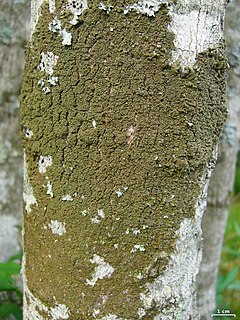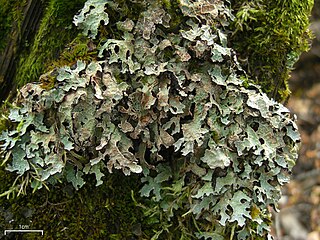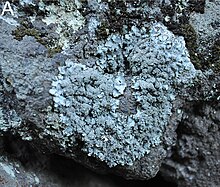
Parmelia is a genus of medium to large foliose lichens. It has a global distribution, extending from the Arctic to the Antarctic continent but concentrated in temperate regions. There are about 40 species in Parmelia. In recent decades, the once large genus Parmelia has been divided into a number of smaller genera according to thallus morphology and phylogenetic relatedness.

Pseudephebe is a genus of fruticose lichens in the family Parmeliaceae. It contains three species that grow on rocks.

Melanohalea is a genus of foliose lichens in the family Parmeliaceae. It contains 30 mostly Northern Hemisphere species that grow on bark or on wood. The genus is characterized by the presence of pseudocyphellae, usually on warts or on the tips of isidia, a non-pored epicortex, and a medulla containing depsidones or lacking secondary compounds. Melanohalea was circumscribed in 2004 as a segregate of the morphologically similar genus Melanelia.

Melanelixia is a genus of foliose lichens in the family Parmeliaceae. It contains 15 Northern Hemisphere species that grow on bark or on wood. The genus is characterized by a pored or fenestrate epicortex, and the production of lecanoric acid as the primary chemical constituent of the medulla. Melanelixia was circumscribed in 2004 as a segregate of the related genus Melanelia.

Punctelia is a genus of foliose lichens belonging to the large family Parmeliaceae. The genus, which contains about 50 species, was segregated from genus Parmelia in 1982. Characteristics that define Punctelia include the presence of hook-like to thread-like conidia, simple rhizines, and point-like pseudocyphellae. It is this last feature that is alluded to in the vernacular names speckled shield lichens or speckleback lichens.

Esslingeriana is a fungal genus in the family Parmeliaceae. The genus is monotypic, containing the single foliose lichen species Esslingeriana idahoensis, commonly known as the tinted rag lichen. It is found in northwestern North America.

Punctelia rudecta, commonly known as the rough speckled shield or the speckleback lichen, is a North American species of foliose lichen in the family Parmeliaceae. This species can be readily identified by the light color of the thallus underside, the relatively large lobes at the edges of the thallus, and the tiny white pores present on the top of the thallus that are characteristic of the genus Punctelia. The lichen is quite abundant and widespread in the eastern and southeastern United States, although it also occurs in Canada and northern Mexico, but is less common in these regions. The lichen usually grows on bark, and less commonly on shaded rocks. There are several lookalike Punctelia species; these can often be distinguished from P. rudecta by differences in distribution or in the nature of the reproductive structures present on the thallus.

Punctelia reddenda is a widely distributed species of foliose lichen in the family Parmeliaceae. It occurs in Africa, Europe, North America, and South America, where it grows on bark and on rock.
Punctelia subpraesignis is a species of foliose lichen in the family Parmeliaceae. It occurs in Mexico, South America, and East Africa, where it grows on bark and on rocks. Major characteristics of the lichen that distinguish it from other Punctelia species include the C+ and KC+ rose spot tests of the medulla, ascospores that are smaller than 20 μm, and unciform (hooklike) conidia.
Punctelia cedrosensis is a species of foliose lichen in the family Parmeliaceae. It is endemic to Mexico, where it grows on the bark of conifers.

Punctelia punctilla is a species of foliose lichen in the family Parmeliaceae. It is found in Africa, South America, and North America, where it grows on bark and on rocks. The main characteristics that distinguish Punctelia punctilla from other species of Punctelia are the presence of isidia on the thallus surface, a pale brown thallus undersurface, and the presence of lecanoric acid in the medulla.

Punctelia hypoleucites, commonly known as the southwestern speckled shield lichen, is a species of foliose (leafy) lichen in the family Parmeliaceae. First formally described by Finnish botanist William Nylander as a species of Parmelia, it was transferred to the genus Punctelia in 1982. The lichen is found in Africa, North America, and South America, where it grows on the bark of both hardwood and coniferous trees. Its greenish-grey thallus is covered with tiny white pseudocyphellae – minute holes in the thallus surface that facilitate gas exchange. Some macroscopic features that help distinguish this species from other related members of the genus include the presence and the structure of the apothecia, the absence of asexual surface propagules, and the light brown color of the thallus undersurface. Chemically, the presence of lecanoric acid in the medulla and atranorin in the cortex help distinguish it from lookalikes.

Punctelia bolliana, the eastern speckled shield lichen, is a species of foliose lichen in the family Parmeliaceae. It is found in North America, with a distribution extending from the Canadian province of Ontario south to the central and northeastern United States and Mexico. It grows on the bark of both deciduous trees and coniferous trees. The combination of characteristics that distinguishes this species from others in genus Punctelia are the absence of the vegetative propagules isidia and soralia, a pale brown lower thallus surface, and the presence of the secondary chemical protolichesterinic acid in the medulla.

Punctelia perreticulata is a widely distributed species of foliose lichen in the family Parmeliaceae. It occurs in Mediterranean Europe and Russia, North America, South America, Australia, and New Zealand, where it grows on rocks, bark, or wood. Its main distinguishing features are its thallus surface, marked with many shallow depressions, grooves, or pits, and sorediate pseudocyphellae. The lower side of the thallus is ivory to tan towards the centre and the major secondary metabolite in the medulla is lecanoric acid. A lookalike species with which it has been historically confused is Punctelia subrudecta; this lichen can be distinguished from Punctelia perreticulata by the texture of the thallus surface, or, more reliably, by the length of its conidia.
Punctelia subflava is a species of foliose lichen in the family Parmeliaceae that occurs in Australia.

Punctelia stictica is a species of foliose lichen in the family Parmeliaceae. It is widely distributed lichen, recorded in Africa, Europe, North America, South America, and Greenland. It is typically found growing on rocks.

Punctelia borreri is a species of foliose lichen in the family Parmeliaceae. It is a common and widely distributed species, occurring in tropical, subtropical, and temperate regions of Africa, Asia, Europe, North America, Oceania, and South America. The lichen typically grows on bark of deciduous trees, and less commonly on rock. Some European countries have reported increases in the geographic range or regional frequency of the lichen in recent decades, attributed alternatively to a reduction of atmospheric sulphur dioxide levels or an increase in temperatures resulting from climate change.
Parmelia mayi is a species of foliose lichen in the family Parmeliaceae. It is found in the northern Appalachian Mountains of eastern North America, where it grows on rocks and on the trunks of paper birch and balsam fir. Parmelia mayi is morphologically indistinguishable from Parmelia saxatilis, but is distinct in its distribution, chemistry, and genetics.

Parmelia barrenoae is a species of foliose lichen in the large family Parmeliaceae. It was formally described as a new species in 2005. Before this, it was lumped together as one of several lichens in the Parmelia sulcata group—a species complex of genetically distinct lookalikes. Parmelia barrenoae is widely distributed, occurring in Europe, western North America, Africa, and Asia.

Parmelia fraudans is a species of foliose lichen in the family Parmeliaceae. It is found in Europe and North America, where it grows on rocks.
















